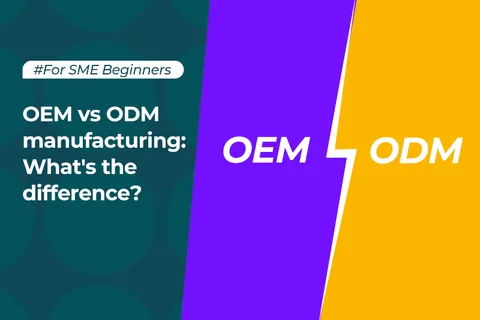OEM vs ODM manufacturing: What's the difference?

OEM vs ODM manufacturing: what’s the difference? If you have an idea for a new product and are looking for a reliable manufacturer to partner up with and bring your products to market, you might have come across the terms OEM and ODM manufacturing. Before you contact a manufacturer, you’ll need to understand the key differences between these two unique business services. Alternatively, if you’re thinking of offering manufacturing services on a global scale, you’ll need to decide which of these two services you can offer.
In this article, we’re going to explain what OEM and ODM manufacturing is, when you might need an OEM manufacturer, and what ODMs can offer that OEMs can’t. Whether you’re an international factory trying to promote your services online, or you’re a company looking to expand your product range with help from a manufacturer, let’s start with the basics.
Table of Contents
What is OEM manufacturing?
OEM stands for “original equipment manufacturer,” and refers to a manufacturer that provides goods or manpower to bring a product to market. OEMs often produce something that is used as a component to a product and is typically associated with a type of service called OEM services.
If you are a company hoping to launch a new product, you might require the services of OEM manufacturing through a B2B portal site like Alibaba.com. Well-established companies that already have products on the market will often have a product development team in place with designers, testers and marketing professionals who have all spent months, if not years, creating a new line of products. Because the company has the original idea, the designs, plans, manufacturing process, and branding ready to go, they only require a manufacturing facility and the manpower to help produce the items and meet product demand, or material to finalize the product and have it ready to sell. In this case, OEM manufacturing is the right service to choose.
If you are a manufacturer and don’t have the capabilities to design, create, test and brand products, you should offer OEM manufacturing and provide basic manufacturing services to help businesses mass-produce products.
Here is an example of how OEM manufacturing works:
A luxury sportswear company has designed a new line of sneakers. They have the designs, branding, market research, and product testing finalized, and they need each pair of sneakers to have a memory-foam sole.
The sportswear company finds a supplier on Alibaba.com that offers OEM service and contacts them about their services.
The OEM has previous experience working with fashion clients and can mass-produce the luxury range of footwear with the memory-foam sole element.
The sportswear company provides the designs, manufacturing requirements, branding, and logo designs, and if required, packaging requirements too.
On Alibaba.com, what does "OEM service offered" mean?
If you are a contract manufacturer that offers OEM services, on Alibaba.com, you can claim your OEM capacity on your digital storefront. Also, you can showcase your professional certifications and third-party approvals to enhance your credibility with the buyers.

What is ODM manufacturing?
Now that we know what OEM manufacturing is, let’s take a look at how ODM is different.
But first, what does ODM stand for? The term ODM stands for “original design manufacturer”. Learning about the ODM meaning is beneficial for entrepreneurs who are looking to scale their businesses efficiently.
An ODM, or “original design manufacturer,” is a company that has the capabilities to design, develop, manufacture and sell products themselves. While OEM is often referred to as a service, ODM is referred to as a product. The ODM definition extends beyond manufacturing—it includes the design, engineering, and production processes. Also, it's worth noting that this ODM definition may vary slightly depending on industry-specific nuances and practices.
The products an ODM creates are often rebranded by a buyer as private label products and are sold for a profit. Unlike an OEM, which relies on a client brief and product design to manufacture items, an ODM often designs and develops products independently or in collaboration with a client. Many businesses opt for ODM services to leverage the expertise of manufacturers while focusing on their core competencies. This is the ideal manufacturing service if you have a great idea but are yet to design, develop, test, or brand it.If you are a manufacturer and have employees or teams who have the skills, experience, and capabilities to design products, develop them, and carry out testing, you will be able to market yourself as an ODM. Reliable ODM services enable businesses to stay competitive in rapidly evolving industries.
Here is an example of how ODM manufacturing works:
A client works in the education industry and has found a gap in the market. With their knowledge of the market, they contact an ODM about their idea to create a schoolbag that includes compartments that chill drinks, food, and snacks, while keeping other parts completely waterproof and stain-proof.
The ODM receives information about the new schoolbag idea and sets up a meeting with the client to discuss the demand for this product in more detail.
During the meeting, the client explains why there is a need for the product and what would be attractive to young students in terms of color scheme and style.
The ODM takes this market insight and develops a school bag that features cooling, water-proof, and stain-proof pockets. Their design team works on the style, fabrics, and specifications of the final design.
Now the ODM can sell the product to the client, which they can rebrand if they wish, or they can sell directly to the consumer.
A little bit about ODM Testing
ODM testing refers to the process of evaluating and assessing products manufactured by an ODM to ensure that they meet quality standards and specifications. It's all about putting your creation through a series of tests to ensure it's top-notch in terms of quality and performance before it hits the market.
During ODM testing, your product goes through a variety of examinations. It's subjected to functionality testing to make sure all the features work as they should. It is also put through performance testing to see how well it handles different situations, and durability testing ensures it can withstand everyday wear and tear.
OEM versus ODM: what’s the difference?
It's important to compare the benefits and limitations of OEM vs ODM in order to choose the right manufacturing model for your specific needs. OEMs and ODMs offer clients two completely different manufacturing services, but both are highly valuable depending on the client and project.

Pros and cons of OEMs
This type of business relationship can be a great way to get a product to market and start generating revenue. By forming an OEM partnership, you will be able to create a product that is difficult to replicate by consumers or competitors due to the cost or time required to produce it. You may also unlock access to new markets, industry sectors, and geographic locations by hiring the services of an OEM.
However, there are some disadvantages to working with OEMs. Providing design briefs to a manufacturer can sometimes cause confusion and require members of your team to travel to the factory and provide support and assistance. This can cost your company time and money. The OEM may also require changes to the product during the manufacturing process that are backed by their manufacturing teams rather than your design brief. Also, by not involving the manufacturing team during the development of the product, they won’t have the opportunity to provide their feedback and advice which could actually make it easier to manufacture and save you money when it comes to production costs.
While OEM and ODM serve distinct purposes, it's important to evaluate your specific requirements and conduct thorough research before making a decision. The decision between OEM vs ODM would depend on factors like product uniqueness, time to market, investment costs, and desired level of control.
Pros and cons of ODMs
ODMs often have a lower minimum order quantity (often referred to as MOQ) requirement, which is why they can be more appealing to work with – especially for clients who want to test out an idea. As the ODM has all the key components to design, manufacture, and brand a product, the cost to develop a new product is usually far less than the cost of working with an OEM. Yet there are some downsides to ODM relationships, which can make clients wary of using an ODM. Because the client is providing an idea rather than a final product design, there are fewer opportunities to customize, make changes, and control product requirements. Some people also worry that their ideas might be stolen by an ODM product owner because the factory has everything they need to make the product themselves without any further input or help from the client. Although this can be the case, there are ways that clients can protect their ideas and manufacturers can offer contracts that give reassurance to new customers.
What is contract manufacturing?
A contract manufacturer can offer businesses additional services such as packaging products, printing labels and providing specific parts. A client might use an OEM to mass-produce a child’s toy, for example, but also require a company to package the final product and print instruction manuals and labels. On the other hand, a contract manufacturer may be given the task to provide additional parts to an end product. If we consider a food product, a contract manufacturing company could provide recyclable food containers, sachets of sauce, or perhaps utensils for fast food items.
If you’re thinking of starting an OEM or ODM business you should consider the following things:
- What resources do you have and where can you add value?
- Do you have the ability to design, develop and test products?
- Is it easier for you to produce a product to a design brief, rather than invest time and money into developing a product yourself?
- How fast can you manufacture items and do you have any limitations?
- How can you make a client feel comfortable working with your business?
- Do you have legal documents in place to protect your team and assets?
Contact us now with any questions about how Alibaba.com can help you grow your manufacturing business and reach your goals!
Latest articles
Understanding And Creating Scalable Businesses
FEBRUARY 03, 202417 MIN READ3D Printing Business Insights And Practical Steps
FEBRUARY 03, 202411 MIN READShould You Make Private Label Products in 2024?
FEBRUARY 03, 20248 MIN READThe Ultimate Guide to Electronic Payments: Types, Pros & Cons, and Expert Tips for Mastery
FEBRUARY 02, 202410 MIN READWhat is Channel Sales? An Ultimate Guide
JANUARY 31, 202414 MIN READHow to Start a Clothing Brand Successfully: Step-by-Step Guide 2024
JANUARY 25, 202411 MIN READBootstrapping Basics: Building a Business from Scratch
JANUARY 25, 20249 MIN READThe Ultimate Guide to Choosing the Best Crowdfunding Platform for Your Project
JANUARY 24, 20248 MIN READ













